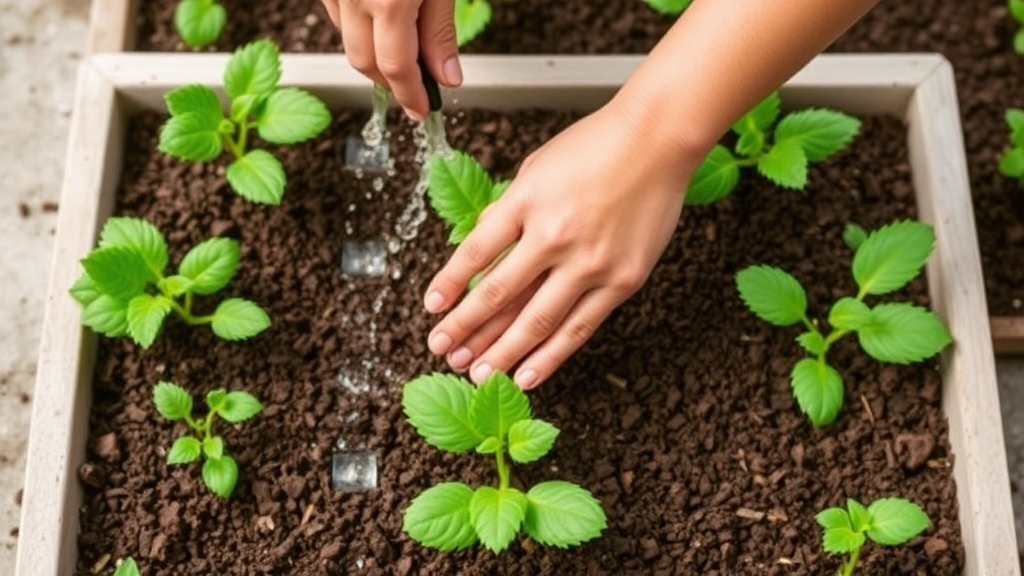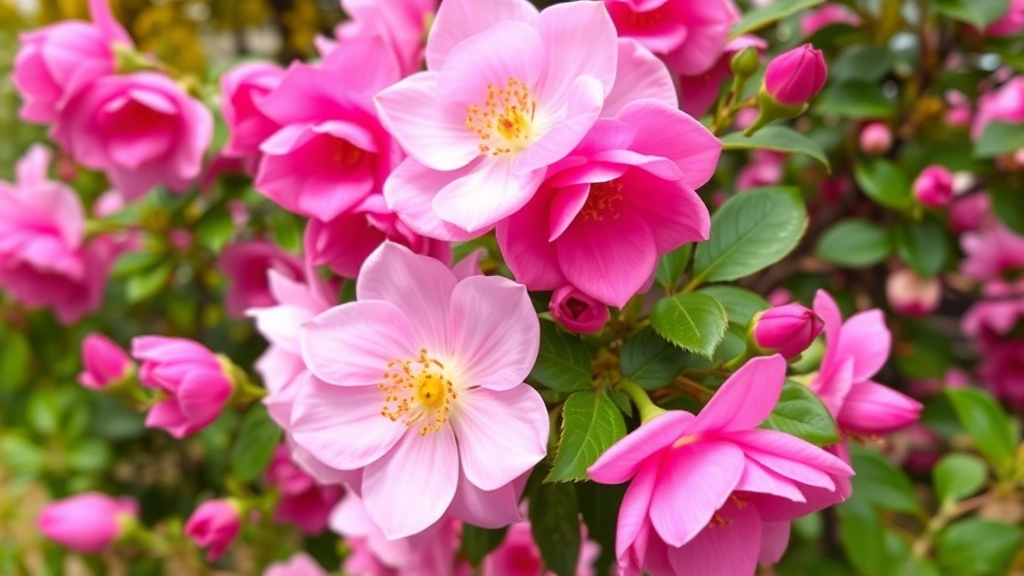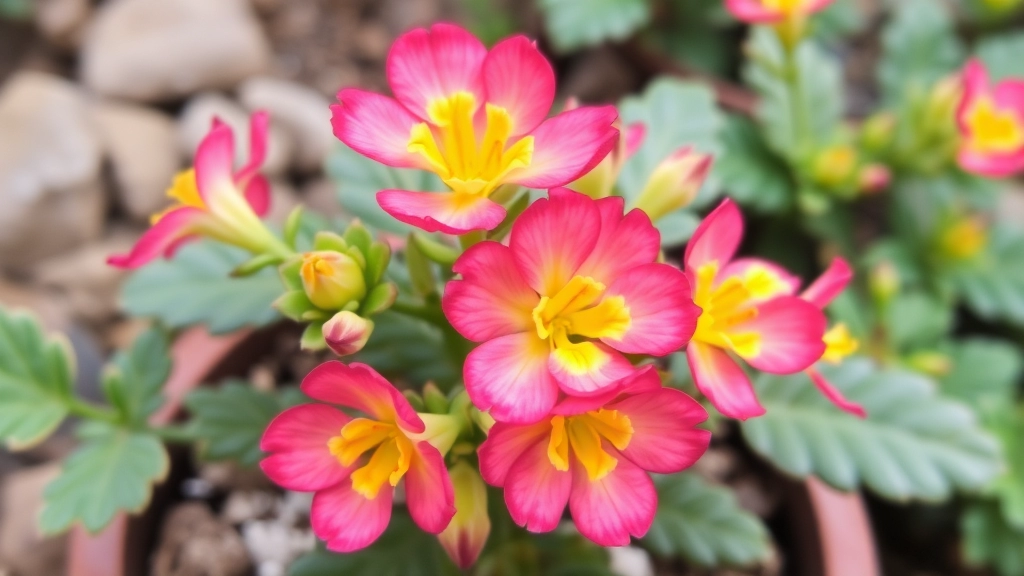Kalanchoe Blossfeldiana Care Guide
Ideal Growing Conditions
When it comes to the Kalanchoe Blossfeldiana Family, understanding the ideal growing conditions is crucial. This vibrant succulent thrives in well-drained soil and requires plenty of sunlight to maintain its colourful blooms. Regular watering, without overdoing it, ensures healthy growth and prevents root rot.
Pest Management
To keep your Kalanchoe Blossfeldiana pest-free, it’s essential to monitor for common issues like aphids and mealybugs. Pruning old blooms encourages new growth, while seasonal care helps in maintaining its decorative appeal both indoors and outdoors.
Gardening Tips
Whether you’re a seasoned gardener or a newbie, these tips will help you make the most of this stunning plant.
Light Requirements
- Bright Indirect Light: Kalanchoe prefers bright, indirect sunlight. Direct sunlight can scorch its leaves.
- South or East Facing Windows: Positioning your plant near a south or east-facing window maximises its light exposure.
Temperature Preferences
- Ideal Range: This plant thrives in temperatures between 18°C and 24°C (65°F to 75°F).
- Avoid Drafts: Keep it away from cold drafts or sudden temperature changes to prevent stress.
Soil Type
- Well-Draining Soil: Use a cactus or succulent mix that allows excess water to drain quickly.
- pH Level: A slightly acidic to neutral pH (6.0-7.0) is ideal for optimal growth.
Humidity Levels
- Low Humidity: Kalanchoe prefers low humidity conditions. High humidity can lead to rot.
- Air Circulation: Ensure good air circulation around the plant to maintain its health.
Container Selection
- Terracotta Pots: These are excellent choices as they allow moisture to evaporate quickly.
- Drainage Holes: Always choose pots with drainage holes to prevent water accumulation.
For more detailed information on caring for Kalanchoe Blossfeldiana, check out our comprehensive guide.
Additionally, if you are looking to propagate your plant, our step-by-step instructions on how to propagate Kalanchoe Blossfeldiana cuttings will be incredibly helpful.
Watering and Fertilization Guidelines for Healthy Growth

So, you’ve got your Kalanchoe Blossfeldiana, and you’re wondering how to keep it thriving.
Watering and fertilization are crucial, and getting them right can be the difference between a happy plant and a sad one.
Watering Tips
- Check the Soil: Before you water, stick your finger about an inch into the soil. If it feels dry, it’s time to give it a drink.
- Water Deeply: When you do water, make sure to soak the soil thoroughly. This encourages deep root growth.
- Avoid Overwatering: Kalanchoe prefers to dry out between waterings. Too much moisture can lead to root rot, which is a real buzzkill for your plant.
- Seasonal Adjustments: During the growing season (spring and summer), you might need to water more often. In winter, cut back significantly.
Fertilization Guidelines
- Choose the Right Fertilizer: A balanced, water-soluble fertilizer (like a 20-20-20 mix) is perfect.
- Frequency: Fertilize every 4-6 weeks during the growing season. In winter, skip the fertiliser altogether.
- Dilution is Key: Always dilute your fertiliser to half-strength. Kalanchoe is sensitive and doesn’t need a full dose.
- Signs of Nutrient Deficiency: If you notice yellowing leaves or stunted growth, it might be time to up your fertilization game.
As you nurture your Kalanchoe Blossfeldiana, it’s essential to be vigilant about potential pests and diseases that could threaten its vibrant blooms.
Common Pests
– **Aphids**: These tiny insects can cluster on new growth, sucking sap and causing leaves to curl.
– **Mealybugs**: Recognised by their white, cotton-like appearance, they can weaken the plant by feeding on its juices.
– **Spider Mites**: Often hiding on the undersides of leaves, these pests leave fine webbing and cause leaf discolouration.
– **Scale Insects**: These pests appear as small, brown bumps on stems and leaves, robbing the plant of nutrients.
Disease Prevention
To keep your Kalanchoe Blossfeldiana healthy, consider these straightforward strategies:
– **Regular Inspection**: Check your plants weekly for any signs of pests or disease. Early detection is key.
– **Proper Air Circulation**: Ensure your plant has enough space around it to prevent fungal infections.
– **Water Management**: Avoid overhead watering to reduce the risk of fungal diseases. Water at the base of the plant instead.
– **Cleanliness**: Remove dead leaves and debris from around the base to discourage pests and disease.
Treatment Options
If you do encounter pests, here are some effective treatments:
– **Insecticidal Soap**: A natural solution that suffocates pests without harming the plant.
– **Neem Oil**: This organic oil disrupts the life cycle of pests and can deter future infestations.
– **Manual Removal**: For larger pests like mealybugs, a cotton swab dipped in alcohol can effectively remove them.
For more detailed guidance on keeping your plant healthy, check out our [Complete Care Guide for Kalanchoe Blossfeldiana Succulent](https://planthq.org/complete-care-guide-for-kalanchoe-blossfeldiana-succulent/) and tips on [Fixing Etiolated Kalanchoe Blossfeldiana](https://planthq.org/fixing-etiolated-kalanchoe-blossfeldiana-lighting-and-care-tips/).
Pruning and Maintenance for Continuous Blooms

Are you struggling to keep your Kalanchoe Blossfeldiana blooming consistently?
Pruning and maintenance are essential to ensure your plant thrives and produces vibrant flowers throughout the year.
Why Prune Kalanchoe Blossfeldiana?
Pruning helps to:
- Remove dead or wilted flowers
- Encourage new growth
- Maintain a compact shape
When to Prune
Timing is crucial for effective pruning:
- After Blooming: Wait until the flowering period ends. This allows the plant to focus energy on new growth.
- Spring: A light trim in early spring can stimulate fresh blooms.
How to Prune
Follow these simple steps for effective pruning:
- Use Clean Tools: Always use sharp, sterilised scissors or pruning shears.
- Cut Back Wilting Flowers: Trim off any dead flowers to promote new bud development.
- Shape the Plant: Remove any leggy stems to maintain a pleasing shape.
- Limit to 1/3: Avoid cutting more than one-third of the plant at a time to prevent shock.
Maintenance Tips
Alongside pruning, regular maintenance is key:
- Dust Leaves: Wipe leaves with a damp cloth to maximise photosynthesis.
- Check Soil Moisture: Ensure the soil is well-draining and not overly saturated.
- Rotate the Pot: Every few weeks, rotate your plant to ensure even sunlight exposure.
Seasonal Blooming Patterns and How to Encourage Re-Blooming
Many Kalanchoe Blossfeldiana enthusiasts often wonder why their plants bloom beautifully but seem to lack a second round of flowers. Understanding the seasonal blooming patterns of this vibrant succulent can help you encourage re-blooming effectively.
Blooming Seasons
Typically, Kalanchoe Blossfeldiana blooms during the late winter to early spring.
- Initial Bloom: This occurs when the plant receives sufficient light and proper care.
- Dormant Period: After the initial bloom, the plant may enter a dormant phase, often lasting until late summer, when it may produce sporadic flowers.
Encouraging Re-Blooming
To encourage your Kalanchoe to bloom again, consider the following tips:
- Light Requirements: Ensure your plant receives bright, indirect sunlight for at least 6 hours a day. A south-facing window is ideal.
- Watering Schedule: Allow the soil to dry out between waterings. Overwatering can lead to root rot and inhibit blooming.
- Pruning: After the first bloom, prune back spent flowers and any leggy growth. This encourages new growth and potential blooms.
- Fertilization: Use a balanced, water-soluble fertilizer every 4-6 weeks during the growing season to provide essential nutrients.
- Temperature Control: Maintain a temperature range of 15-21°C (60-70°F). Sudden temperature drops can stress the plant and hinder blooming.
Real-Life Example
I once had a Kalanchoe that bloomed vibrantly in spring. After the flowers faded, I followed the above steps, and by late summer, it surprised me with another stunning display! For more detailed care tips, you might find this complete care guide for Kalanchoe Blossfeldiana helpful. Additionally, if you’re interested in propagation, check out this guide on how to propagate Kalanchoe Blossfeldiana cuttings.
Indoor and Outdoor Landscaping Uses of Kalanchoe Blossfeldiana
So, you’re thinking about how to use Kalanchoe Blossfeldiana in your space? You’re in the right spot! This vibrant succulent isn’t just a pretty face; it has some fantastic landscaping potential, both indoors and outdoors.
Indoor Uses
- Brighten Up Your Home
Kalanchoe Blossfeldiana is perfect for adding a splash of colour to your living room, kitchen, or office.- Place them on windowsills where they can soak up sunlight.
- They thrive in bright, indirect light, making them ideal for indoor environments.
- Table Centrepieces
Use these beauties as centrepieces on dining or coffee tables.- Group them in clusters for a stunning visual impact.
- Mix and match with other houseplants for a lively arrangement.
- Gift Ideas
They make lovely gifts for friends and family.- A potted Kalanchoe can brighten someone’s day.
- Pair it with a cute pot for an extra touch.
Outdoor Uses
- Garden Borders
Kalanchoe Blossfeldiana works wonders as a border plant in your garden.- Their vibrant blooms can outline pathways or flower beds.
- They’re low-maintenance and drought-resistant, perfect for busy gardeners.
- Rock Gardens
These succulents shine in rock gardens, adding texture and colour.- Pair them with stones and other drought-tolerant plants for a stunning display.
- They’re great for creating a Mediterranean vibe.
- Container Gardens
If you’re short on space, consider container gardening.- Kalanchoe Blossfeldiana looks fantastic in pots on patios or balconies.
- Mix them with trailing plants for a dynamic look.
The Magic of Versatility
Whether you’re sprucing up your home or garden, Kalanchoe Blossfeldiana offers versatility like no other. Its vibrant blooms and easy-care nature make it a go-to choice for both indoor and outdoor settings. For more detailed care tips, check out our Complete Care Guide for Kalanchoe Blossfeldiana. And if you want to explore the stunning array of colors this plant offers, don’t miss our Vibrant Kalanchoe Blossfeldiana Colors Guide.
FAQs on Kalanchoe Blossfeldiana Care
What are the essential watering tips for Kalanchoe Blossfeldiana?
Watering is crucial for the health of your Kalanchoe. It’s important to check the soil moisture before watering. Stick your finger about an inch into the soil; if it feels dry, it’s time to water. Always water deeply to encourage root growth but avoid overwatering as it can lead to root rot. Adjust your watering schedule seasonally, watering more during the growing season (spring and summer) and less in the winter.
How often should I fertilize my Kalanchoe?
Fertilize your Kalanchoe every 4-6 weeks during the growing season with a balanced, water-soluble fertilizer, like a 20-20-20 mix. In winter, you should skip fertilization altogether. Always dilute the fertilizer to half-strength to avoid overfeeding.
Why is pruning important for Kalanchoe Blossfeldiana?
Pruning helps remove dead or wilted flowers, encourages new growth, and maintains a compact shape. This ensures your plant remains healthy and continues to produce vibrant blooms.
When is the best time to prune my Kalanchoe?
The best time to prune your Kalanchoe is after the blooming period ends, allowing the plant to focus its energy on new growth. A light trim in early spring can also stimulate fresh blooms.
How should I prune my Kalanchoe Blossfeldiana?
Use clean, sharp, and sterilized tools to prune your Kalanchoe. Trim back any wilting flowers and remove leggy stems to maintain a pleasing shape. Avoid cutting more than one-third of the plant at a time to prevent shock.
What are some maintenance tips for Kalanchoe Blossfeldiana?
Regular maintenance is key for a healthy Kalanchoe. Dust the leaves with a damp cloth to maximize photosynthesis. Ensure the soil is well-draining and not overly saturated. Rotate the pot every few weeks to ensure even sunlight exposure.
What signs indicate that my Kalanchoe needs more nutrients?
If you notice yellowing leaves or stunted growth, it might be time to increase your fertilization efforts. Ensure you are following the recommended fertilization guidelines for the best results.
References
-
Kalanchoe Plant Care â How To Grow A Flowering Kalanchoe
-
How to Grow Kalanchoe Indoors
-
Kalanchoe: How to Grow and Care for Kalanchoe Plants
